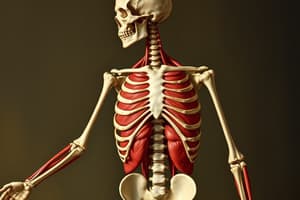Podcast
Questions and Answers
Match the following types of epithelium with their descriptions:
Match the following types of epithelium with their descriptions:
Squamous epithelium = Flattened and thin cells Cuboidal epithelium = Boxy, as wide as it is tall Columnar epithelium = Rectangular, taller than it is wide Pseudostratified epithelium = Single layer of irregularly shaped cells that give the appearance of more than one layer
Match the following types of cell junctions with their functions:
Match the following types of cell junctions with their functions:
Tight junctions = Restrict movement of fluids between adjacent cells Gap junctions = Allow direct communication and passage of ions and small molecules between cells Anchoring junctions = Provide strong yet flexible connection between epithelial cells Adherens junctions = Help epithelial layers resist separation during various contractile activities
Match the following features with their functions in epithelial tissues:
Match the following features with their functions in epithelial tissues:
Cilia = Allow movement of fluids and particles along the cell surface Basal lamina = Forms a basement membrane to anchor layers together Glycoproteins and collagen secretion = Forms basal lamina by interacting with the reticular lamina from connective tissue Mucous secretion = Traps incoming microorganisms and particles
Match the following characteristics of transitional epithelium with their descriptions:
Match the following characteristics of transitional epithelium with their descriptions:
Match the following functions with their description in epithelial tissues:
Match the following functions with their description in epithelial tissues:
Match the following types of tissues with their primary functions:
Match the following types of tissues with their primary functions:
Match the following structural features of epithelial tissue with their descriptions:
Match the following structural features of epithelial tissue with their descriptions:
Match the following types of membranes with their locations:
Match the following types of membranes with their locations:
Match the following types of muscle fibers with their characteristics:
Match the following types of muscle fibers with their characteristics:
What are the principal types of muscles?
What are the principal types of muscles?
What are the important structural features of epithelial tissue?
What are the important structural features of epithelial tissue?
From which embryonic layers do epithelial tissues originate?
From which embryonic layers do epithelial tissues originate?
What is the comparison between cartilage and bone?
What is the comparison between cartilage and bone?
What are the functions of the skeletal system?
What are the functions of the skeletal system?
What is the mechanism of muscle contraction and relaxation?
What is the mechanism of muscle contraction and relaxation?
What are the two surfaces exhibiting polarity in epithelial tissues?
What are the two surfaces exhibiting polarity in epithelial tissues?
What is the function of cilia in epithelial cells?
What is the function of cilia in epithelial cells?
What is the role of the basement membrane in epithelial tissues?
What is the role of the basement membrane in epithelial tissues?
What is the primary function of epithelial tissues in the body?
What is the primary function of epithelial tissues in the body?
What are the three basic types of cell-to-cell junctions in epithelial tissues?
What are the three basic types of cell-to-cell junctions in epithelial tissues?
What is the difference between simple and stratified epithelium?
What is the difference between simple and stratified epithelium?
What is the appearance of pseudostratified epithelium?
What is the appearance of pseudostratified epithelium?
Where are tight junctions observed in epithelial tissues, and what is their function?
Where are tight junctions observed in epithelial tissues, and what is their function?
What type of epithelium can vary in shape and the number of layers present?
What type of epithelium can vary in shape and the number of layers present?
What are the structural adaptations of epithelial cells, aiding in their functions?
What are the structural adaptations of epithelial cells, aiding in their functions?
Flashcards are hidden until you start studying
Study Notes
Epithelial Tissue
- Epithelial tissues originate from embryonic layers (endoderm, mesoderm, and ectoderm)
- Principal functions of epithelial tissues: protection, absorption, secretion, excretion, and sensation
- Important structural features of epithelial tissue: polarity, supported by basement membrane, and cellular junctions
Types of Epithelium
- Simple epithelium: single layer of cells, for absorption and secretion
- Stratified epithelium: multiple layers of cells, for protection
- Pseudostratified epithelium: single layer of cells, but appears stratified due to varying cell heights
- Transitional epithelium: adapts to stretching, found in urinary bladder
Cell Junctions
- Three basic types of cell-to-cell junctions: tight junctions, desmosomes, and gap junctions
- Tight junctions: prevent leakage, found in simple epithelium (e.g., intestine, kidney)
Muscle Tissues
- Principal types of muscles: skeletal, smooth, and cardiac
- Characteristics of muscle fibers: voluntary/involuntary, striated/non-striated, and multi-nucleated
Basement Membrane
- Role of basement membrane: separates epithelial tissue from underlying connective tissue
Skeletal System
- Functions of skeletal system: support, protection, movement, blood cell production, and storage of minerals
Muscle Contraction and Relaxation
- Mechanism of muscle contraction and relaxation: sliding filament theory
Cilia
- Function of cilia: movement of substances along epithelial surface (e.g., respiratory tract)
Membranes
- Types of membranes: basement membrane, plasma membrane, and mucous membrane
- Locations of membranes: epithelial tissue, connective tissue, and body cavities
Studying That Suits You
Use AI to generate personalized quizzes and flashcards to suit your learning preferences.




